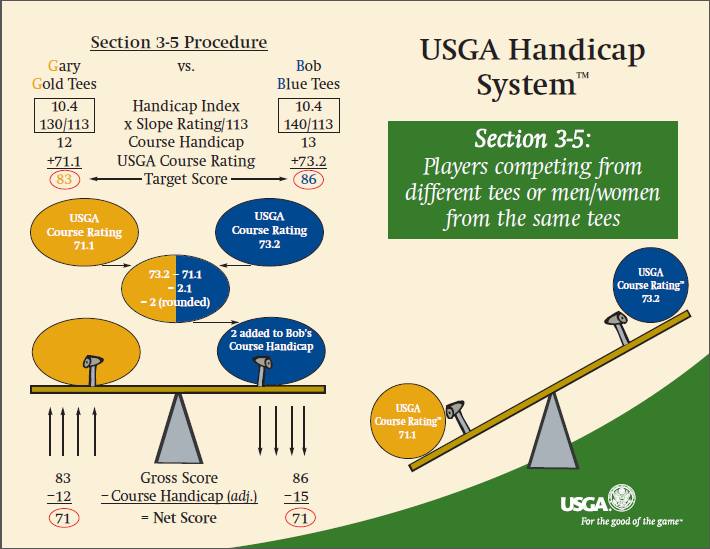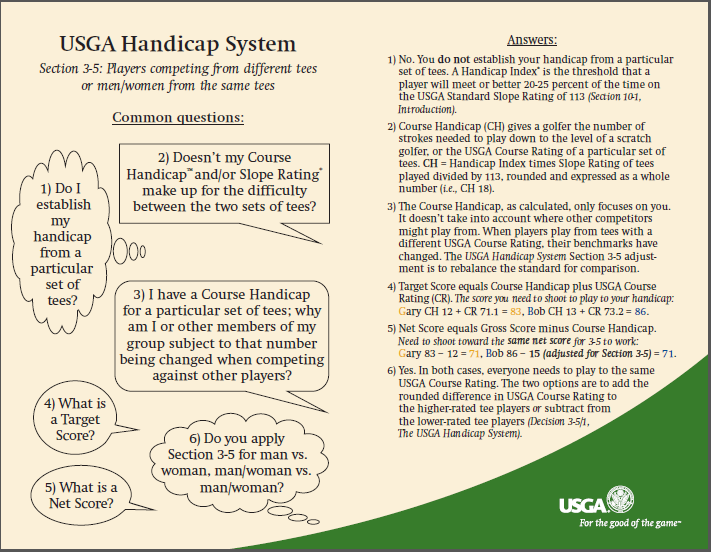Handicap System
Handicap and How it Relates to You
The Handicap System is defined in the rules of golf. The rules are set in joint agreement between the Royal and Ancient Golf Club of Saint Andrews (R&A) and the United Stated Golf Association (USGA). The purpose of the handicap system is to level the playing field between amateur golfers of different abilities, sexes and ages.
Players are issued a Golf Handicap Index Number (GHIN) which is linked to the organization that keeps their handicap. Each player has a unique GHIN number which is accepted worldwide. In the United States handicaps are established by more local golf organizations under USGA rules. In Northern California, handicaps are kept by the Northern California Golf Association (NCGA). To become a member of the NCGA, you must first be a member of a golf club. This can be a private club, a club at a public golf course or an affiliate club. There is also an internet based membership called an eClub. The Metropolitan Golf Association covers the New York City area and vicinity. The local Associations all follow the rules set up by the USGA. I imagine that most golfers in the US do not have an established official handicap.
In reality, if you do not play in tournaments, you do not need an official handicap. However, even if you just play with friends, knowing your handicap index and course handicap allows you to see who gives strokes and receives strokes for bragging rights. If you are interested you can keep and calculate your own handicap, by simply understanding how handicaps are calculated. Below, I show examples of how you can easily calculate your own handicap.
How to Calculate Your Own Handicap
The handicap system calculates handicap indexes. This index neutralizes the difficulty of the different golf courses you played. From this index, one can calculate a course handicap which varies by the ratings of the golf course. Each golf course that has been rated (see NCGA.org) has a slope rating and a course rating from each of the Tee boxes. Some of the Tee boxes are rated for women also and are listed as such. The men’s and women’s ratings are different. The USGA system requires that all scores are recorded along with the slope and course rating. Your index is calculated from the best 10 scores out of your last 20 rounds. It is a rolling number. The NCGA updates handicap indexes on the 1st and 15th of each month.
Handicap indexes are calculated by subtracting the Course Rating from you score, multiplying the difference by 113 (constant) and dividing by the slope.
Let’s try an example calculation:
Example 1:
Course Rating: 70 Slope: 118
Your score for 18 holes is 98.
98 – 70 = 28 28 x 113/ 118 = 26.81 rounded to 26.8 index
Example 2:
Course Rating: 70.2 Slope: 130
Your score for 18 holes is 92.
92 – 70.2 = 21.8 x 113/ 130 = 18.95 rounded to 19 index
In actuality your index is an average of your best 10 scores out of your last 20 rounds. You perform this calculation for each round and then get the average.
Course Handicap
Your handicap for a specific golf course would be:
Your Index x Course Slope/ 113
Adjusting Handicaps when Players use Different Tee Boxes
One of the great things about golf is that it’s a game for life. However, the simple fact is that as we get older, even though we may still play good golf, we usually lose distance. The USGA suggest that people who drive the ball a shorter distance should move up to a more forward Tee box. At my club, there are 5 Tee positions: Blue, Green, White, Brown and Gold. All of the Tees boxes have Men’s ratings. The White, Brown and Gold Tees are also rated for Women.
Usually when husband and wives play, they Tee off from different positions. They also do not play a competition so handicap really doesn’t matter. However, sometimes in a tournament player will Tee off from different positions or Men and Women playing from the same tees. They therefore are playing different courses with different ratings. The USGA compensates for this using Rule 3-5. I have included the USGA explanation below.


For additional information on handicap, I have excerpted the USGA Manual below. You can link to the manual if desired.

The following is excerpted from the “USGA Handicap System Manual:”
Section 1 PURPOSE, AUTHORIZATION, and LICENSING
Definitions
Within each section, all defined terms are in italics and are listed alphabetically in Section 2 – Definitions.
1-1. Purpose
The purpose of the USGA Handicap System is to make the game of golf more enjoyable by enabling players of differing abilities to compete on an equitable basis. The System provides a fair Course Handicap for each player, regardless of ability, and adjusts a player’s Handicap Index up or down as the player’s game changes. At the same time, the System disregards high scores that bear little relation to the player’s potential ability and promotes continuity by making a Handicap Index continuous from one playing season or year to the next. A Handicap Index is useful for all forms of play, and is issued only to individuals who are members of a licensed golf club.
Two basic premises underlie the USGA Handicap System, namely that each player will try to make the best score at every hole in every round, regardless of where the round is played, and that the player will post every acceptable round for peer review. The player and the player’s Handicap Committee have joint responsibility for adhering to these premises.
A Handicap Index, issued by a golf club or authorized golf association (through its member clubs), indicates a player’s skill and is a number taken to one decimal place, e.g., 10.4.
A Handicap Index compares a player’s scoring ability to the scoring ability of a scratch golfer on a course of standard difficulty. A player posts scores along with the appropriate USGA Course Rating and Slope Rating to make up the scoring record. A Handicap Index is computed from no more than 20 scores plus any eligible tournament scores. It reflects the player’s potential because it is based upon the best handicap differentials posted for a given number of rounds, ideally the best 10 of the last 20 rounds.
A Handicap Index is portable from course to course, as well as from one set of tees to another set of tees on the same course. A player converts a Handicap Index to a Course Handicap based on the Slope Rating of the tees played.
A USGA Course Rating is the USGA’s mark that indicates the evaluation of the playing difficulty of a course for a scratch golfer under normal conditions based on yardage and other obstacles that affect scoring ability. A Slope Rating is a measurement of the relative difficulty of a course for players who are not scratch golfers. Each course is rated from each set of tees for both the scratch golfer and the bogey golfer. The USGA Course Rating and Slope Rating together reflect the difficulty of the course for a player who is not a scratch golfer. The greater the difference between the scores of the scratch and bogey golfers on a certain course, the higher the Slope Rating will be and the more strokes players will receive. Conversely, the less the difference, the lower the Slope Rating will be and the fewer strokes players will receive.
Each player locates the Handicap Index on the appropriate Course Handicap Table and finds the corresponding Course Handicap. A Course Handicap Table can be found in the clubhouse or near the first tee of a golf course. There will be a Course Handicap Table for each set of tees used by men and by women. The number of strokes a player receives (Course Handicap) is based upon the relative difficulty (Slope Rating) of the course.